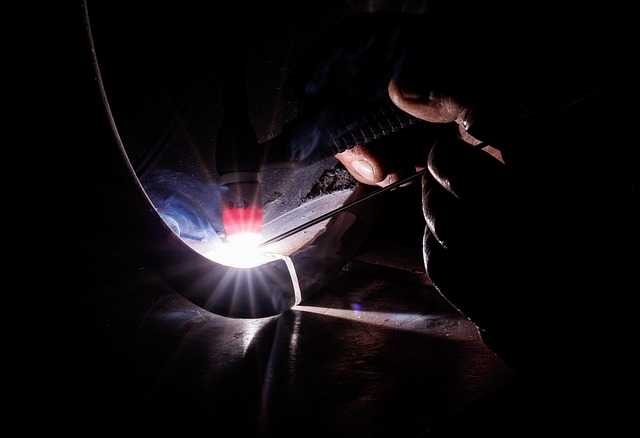Table of Contents
- Exploring the Aesthetic of Darkness in Art
- The Emotional Depth of Shadow and Light
- Techniques for Creating Powerful Dark Imagery
- Finding Inspiration in the Macabre and Mysterious
- Q&A
- In Conclusion


Exploring the Aesthetic of Darkness in Art
The exploration of shadow and absence in visual art reveals a profound emotional landscape. Artists have long turned to the darker aspects of existence to invite viewers into a dialogue that transcends mere aesthetic appreciation. The use of voids, shadows, and monochromatic palettes emphasizes a sense of mystery and introspection. Works that embrace this aesthetic often evoke feelings of unease, curiosity, or even solace, drawing the audience into a realm that challenges conventional beauty. Through the interplay of light and dark, artists invite us to confront our own fears and vulnerabilities.
Key elements that define the aesthetic of darkness include:
- Contrast: Stark differences between light and dark to create drama and tension.
- Texture: The use of rough and smooth surfaces enhances the visual experience.
- Symbolism: Common motifs such as decay, absence, and shadow signify deeper existential themes.
- Composition: Strategic placement of dark elements directs the viewer’s gaze and emotional response.
Throughout art history, various movements have harnessed the power of darkness to communicate complex narratives. From the haunting chiaroscuro of Caravaggio to the surreal, nightmarish landscapes of Francisco Goya, the aesthetic has found its footing across a spectrum of styles. Contemporary artists continue to embrace and transform this theme, often incorporating modern techniques and media that reflect society’s often tumultuous relationship with fear, anxiety, and the unknown. By infusing personal experiences into their dark themes, these creators connect with audiences on an emotional level that is both raw and authentic.
| Artist | Key Work | Era |
|---|---|---|
| Caravaggio | The Calling of Saint Matthew | Baroque |
| Francisco Goya | The Third of May 1808 | Romanticism |
| Edvard Munch | The Scream | Expressionism |
| Yayoi Kusama | Infinity Mirror Rooms | Contemporary |
The continued fascination with darkness in art invites us to examine the intricacies of the human experience. By allowing shadows to play a crucial role in the visual narrative, artists reveal the multifaceted nature of emotion and existence. No longer is darkness simply a backdrop; it becomes an essential element of storytelling that deepens our understanding of beauty in its many forms. As viewers engage with these works, they are compelled to reflect on their own relationship with darkness, both in art and life.
The Emotional Depth of Shadow and Light
Art has the remarkable ability to evoke a myriad of emotions, and this is particularly evident when exploring the themes of darkness and light. Artists often navigate the complexities of the emotional spectrum, using shadow to convey depth and nuance. The contrast between dark and light not only creates visual interest but also symbolizes the internal struggles faced by individuals, inviting viewers to engage in a profound dialogue with the piece. Through careful manipulation of these elements, artists can communicate feelings of despair, hope, and everything in between.
In works that delve into darker themes, shadows often serve as a vessel for raw emotion. They represent the fears, anxieties, and uncertainties that lie beneath the surface of consciousness. This interplay can manifest in various forms, such as haunting portraits with deep shadows that highlight vulnerability, or abstract forms where darkness engulfs light, suggesting a battle that is both personal and universal. Each brush stroke becomes a medium through which the artist conveys the struggles and triumphs that define the human experience.
Conversely, light can stand as a beacon of hope and resilience in the face of darkness. In many pieces, bursts of light breaking through shadows create a sense of refuge and possibility, symbolizing growth and redemption. These captivating moments can be depicted in various ways, from soft, ethereal glows to stark, dramatic illuminations that draw the viewer’s eye. The effective use of light balances the emotional weight of shadow, allowing for a richer narrative that resonates deeply within the heart.
To illustrate this duality, consider the following table comparing different artistic elements associated with shadow and light:
| Art Element | Emotional Impact | Example Art Movement |
|---|---|---|
| Shadow | Evokes feelings of obscurity and introspection | Romanticism |
| Light | Conveys clarity and optimism | Impressionism |
| Contrast | Highlights tension and resolution | Baroque |
Ultimately, the emotional terrain that shadow and light create in art touches on the complexities of human emotion. The mastery of these elements allows artists to craft narratives that reflect both the darkness and illumination found in life, inviting viewers to not only witness but also experience the spectrum of human emotions in a profound and enriching way.


Techniques for Creating Powerful Dark Imagery
Creating powerful dark imagery requires a deep understanding of both the visual and emotional elements of art. Contrast plays a pivotal role in emphasizing dark tones; by pairing deep blacks with sharp whites or muted colors, artists can evoke stark emotional responses. This shock of contrast draws the viewer’s eye, guiding them through the piece while amplifying the sense of foreboding or mystery. Additionally, textural elements—like rough brush strokes or intricate patterns—can enhance the overall depth, encouraging the audience to explore every corner of the artwork.
A key technique in this genre is the use of symbolism. Every object or color can carry a significant meaning that transcends the literal. For instance, a wilting flower may signify decay, while shadows can represent fear or the unknown. To convey your themes effectively, consider incorporating objects with layers of meaning, allowing viewers to engage intellectually with your work. You might also explore dark themes within your narratives, such as isolation, loss, or introspection, which resonate universally yet vary in interpretation.
Lighting is integral to achieving the right mood; dramatic lighting can transform a piece from mundane to haunting. Techniques such as chiaroscuro—where light and shadow are used in stark contrast—can help emphasize the emotive qualities of your subject. Experiment with different light sources, like candlelight or moonlight, that inherently carry a mystique and can alter perception. Here, you’ll create not just an image but an atmosphere, encapsulating the viewer in a moment thick with emotion.
Lastly, bringing an organic element to your dark imagery can ground your artwork, giving it a tangible quality. Consider using a mix of traditional and modern mediums, such as charcoal for its rich blacks and digital techniques to integrate unexpected elements. Implementing mixed media can add a level of complexity and uniqueness to your pieces. For instance, pairing photographs with paint or digital art can create a captivating juxtaposition, inviting the viewer to interpret the layers of the piece creatively. By blending these various approaches, your dark imagery can transcend boundaries, leaving a lasting impression on all who encounter it.


Finding Inspiration in the Macabre and Mysterious
For many artists, navigating the depths of the macabre can be a profound source of creativity. It invites exploration into the darker facets of human emotion and life experiences, often untouched in more conventional art forms. This intrigue can manifest in various mediums, from painting and sculpture to digital art, making the mysterious both a subject and a muse. Artists may find themselves captivated by themes such as death, decay, and the supernatural, pushing the boundaries of traditional aesthetics.
Engaging with these themes often leads to a rich tapestry of visuals and narratives. Here are some elements that can ignite creativity:
- Gothic Literature: Drawing inspiration from literary works that explore darker themes can spark ideas for visual representations.
- Historical Events: Examining infamous events in history, from tragedies to unsolved mysteries, can provide a backdrop for artistic exploration.
- Folklore and Mythology: Tales of spirits, ghosts, and mythical creatures present endless opportunities for artistic interpretation.
- Nature’s Duality: The beauty found within decay—like withering flowers or eroded landscapes—can serve as poignant symbols in art.
To effectively channel this inspiration, artists often employ a unique color palette that echoes the somber themes they explore. Dark hues, shadowy undertones, and stark contrasts can evoke feelings of unease and fascination. In the process, they often break convention, using texture and form to enhance the emotional impact of their work. Here’s a look at how various elements contribute to this artistic expression:
| Element | Impact |
|---|---|
| Color | Sets mood; deep blues and blacks can evoke melancholy. |
| Texture | Adds depth; rough surfaces can create a sense of unease. |
| Form | Distorted shapes can reflect inner turmoil or chaos. |
The allure of the macabre is not just about exploring darkness, but rather about confronting the complexities of existence. Through this lens, artists can express emotions and concepts that resonate with many, offering viewers a glimpse into the unsettling yet beautiful duality of life. The mysterious narratives behind dark themes provide fertile ground for discussion and interpretation, making art inspired by the eerie and enigmatic resonate on multiple levels. By embracing the unknown, artists can carve unique paths that challenge perceptions, inviting audiences to engage with both the dark and the light within their work.
Q&A
Q&A on Darkness Art
Q: What exactly is darkness art? A: Darkness art is a genre that delves into themes of fear, sorrow, and the unknown. It encompasses various mediums—painting, sculpture, photography, and digital art—focusing on the aesthetic and emotional components of darkness. Artists use this genre to explore the human experience, confronting the shadows that often lurk within our psyche and society.Q: Why do artists choose to work with dark themes? A: Artists often gravitate towards dark themes as a means of self-expression or social commentary. Darkness can symbolize personal struggles, mental health issues, or societal challenges. By exploring these themes through their work, artists have the opportunity to evoke powerful emotions, provoke thought, and invite discussions about topics that are often shunned or overlooked.
Q: How has darkness art evolved over time? A: Darkness art has a rich history that spans centuries, influencing and influenced by movements such as Romanticism, Expressionism, and Surrealism. In more contemporary contexts, it has assimilated techniques from various cultures and styles, melding traditional motifs with modern interpretation, thereby remaining relevant in today’s art scene.
Q: Can you name some notable artists associated with darkness art? A: Certainly! Renowned artists such as Francisco Goya, with his haunting depictions of war and madness, and Edgar Allan Poe, known for his macabre storytelling, have both contributed significantly to the world of darkness art. More modern figures like H.R. Giger and Sylvia Ji also create visually compelling works that encapsulate the essence of darkness, each with their unique interpretations.
Q: What role does darkness play in the appreciation of art? A: Darkness can enhance the appreciation of art by adding layers of meaning and emotion. It invites viewers to confront their own fears and biases, fostering a deeper connection with the piece. Art that embraces darkness encourages a reflective experience, allowing audiences to navigate complex feelings while gaining insights into the human condition.
Q: How can someone begin to appreciate darkness art? A: To appreciate darkness art, one should approach it with an open mind and a willingness to explore emotional depths. Consider analyzing the colors, textures, and subjects portrayed. Reflect on how these elements evoke feelings and thoughts. Additionally, reading artist statements or critiques can provide valuable context and enhance your understanding of the work’s message.
Q: Is darkness art only for a niche audience? A: While darkness art may resonate more with certain individuals, its themes are universal. Many people grapple with emotions and experiences tied to darkness, making this genre accessible to a broad audience. It can serve as a mirror to our struggles and fears, fostering empathy and connection among diverse viewers.
Q: Are there any misconceptions about darkness art? A: Yes, one common misconception is that darkness art promotes negativity or violence. In reality, many artists use this genre to provoke thought and foster dialogue about serious issues. It’s an exploration of the human experience rather than an endorsement of despair. The aim is often to illuminate rather than obscure, providing insight into the complexities of life.
Q: How does one create darkness art? A: Creating darkness art begins with introspection. Artists should reflect on their feelings, fears, and societal observations. Experimenting with techniques and materials that evoke darkness, such as muted colors or stark contrasts, can aid in expressing these themes. Embracing vulnerability and authenticity is also crucial, as it helps convey genuine emotion through the artwork. — This Q&A serves as a guide for those intrigued by the compelling world of darkness art, encouraging a thoughtful exploration of its depths and meanings.
